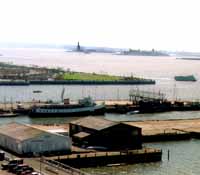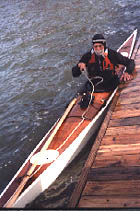

After-drop Phenomenon
Continued core temperature drop immediately following the removal from the water.
Components:
- Heat
conduction from the core to the periphery until homeostasis achieved
- Venous return of blood from the cold periphery to the warmer core
Factors for cold water survival
1. ability to swim
Variables affecting cooling times in cold water
1. water temperature
2. survivorís percentage of body fat
3. type of protective clothing worn
4. survivorís behavior
5. percentage of survivorís body immersed in water
Expected cold water survival without protective clothing (From US Coast Guard)
T (0F) Exhaustion/Unconsciousness Expected survival
32 <15 minute 10-45minutes
32-40 15-30 minutes 40-90 minutes
40-50 30-60 minutes 1-3 hrs
50-60 1-2 hrs 1-6 hrs
60-70 2-7 hrs 2-40 hrs
70-80 3-13 hrs 3-indefinitely
>80 indefinitely? indefinitely?
1. Sudden
reduction of the hydrostatic squeeze + hypovolemia = hypotension
Maintain hypothermic persons in a horizontal position.
2. Continuous
drop of the core temperature ó after-drop, especially with activity
Avoid any physical activity. Do not massage the extremities.
3. Cold
heart muscle is susceptible to arrhythmias ó fibrillation, asystole
Handle victims gently, avoid excessive mechanical stimulation.